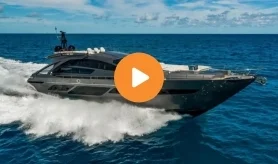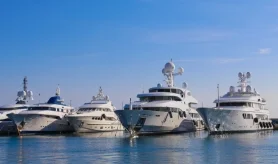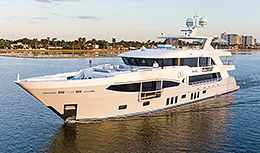- Alaskan Yachts
- Azimut Yachts
- Back Cove Yachts
- Beneteau Yachts
- Benetti Superyachts
- Bertram Yachts
- Boston Whaler
- Broward Yachts
- Buddy Davis Sportfish
- Burger Yachts
- Cabo Yachts
- Catamarans
- Carver Motoryachts
- Center Console
- Chris-Craft Yachts
- Cruisers Yachts
- DeFever Trawlers
- Dufour Sailboats
- Fairline Yachts
- Feadship Yachts
- Ferretti Yachts
- Formula Yachts
- Fountaine Pajot Cats
- Grady-White
- Grand Banks Trawlers
- Hargrave Yachts
- Hatteras Yachts
- Hinckley Picnic Boats
- Horizon Yachts
- Hydra-Sports
- Intrepid Boats
- Jarrett Bay Sportfish
- Jeanneau Yachts
- Kadey-Krogen Trawlers
- Lazzara Yachts
- Lekker Boats
- Luhrs Sportfish
- Marlow Yachts
- Maritimo Yachts
- Marquis Yachts
- Mazu Yachts
- McKinna Motoryachts
- Meridian Yachts
- Midnight Express
- MJM Yachts
- Mochi Craft
- Neptunus Motoryachts
- Nordhavn Trawlers
- Nordic Tugs
- Numarine Yachts
- Ocean Alexander Yachts
- Ocean King
- Offshore Yachts
- Outer Reef
- Oyster Sailing Yachts
- Pacific Mariner Yachts
- Palmer Johnson Yachts
Boat Review: 36 Dufour Classic
Boat Review: 36 Dufour Classic

Source: Greg Jones, Sailingmagazine.net
We had just left Racine’s Reefpoint Marina on the Dufour 36 Classic, with 15 knots of southeast winds waiting for us on Lake Michigan. We powered up into the wind and raised the main, followed almost immediately by rolling out the genoa. The boat heeled into the wind as we fell off and began to sail. After a few minutes, Brad Strand, co-owner of Riverside Marine, quietly suggested that perhaps we would like to shut off the engine. The 30-horsepower Volvo 2030, ticking over at 1000 rpm, was so quiet no one had noticed it was still running.
Beginning a sailboat review by talking about the engine might be a bit unusual, but the silence and lack of vibration of the engine, due in large part to the saildrive and generous sound insulation, makes this a good place to start. While putting the boat through her paces under power, I was just as pleasantly surprised at the maneuverability. The large, semi-balanced rudder, with roughly 25 percent of its surface forward of the rudder post, catches the prop wash and pivots the boat smartly. The boat will reverse direction to port in less than a boat length, and to starboard in slightly more than that.
Thanks to the flawless rack-and-pinion steering, transmitted by metal rods, reversing lacks the drama sometimes found with cable steering. This is a boat you could back out of a slip with wind and tide opposing, and make it look easy.
The fixed-pitch, two-blade prop is standard, and even at maximum rpm there was no “drumming,” a problem sometimes with two-blade props running in small apertures.
Suggested maximum sustained rpm is 2900, which gives 6.6 knots, just under the calculated hull speed of 7.7 knots. At a more efficient and nearly silent 900 rpm, the Dufour 36 moves along at 3.1 knots.
Under sail
But it is primarily a sailboat. With the engine off, we tucked her up onto a close reach, squeezing into the upper portion of her polars and discovering a boat that would still make way at 35 degrees apparent. In 11.2 knots of true wind, we sped along between 6.5 and 7.2 knots, with most of the variation occurring because of swells. Falling off to a broad reach gave us almost another 2 knots.
Steering was light, literally one-finger, and completely neutral, with the genoa sheeted in about midway back on the track and the traveler slightly to leeward of midships. The leech of the main was just to leeward of the backstay, and the wake showed virtually no leeway being made. This is a boat that will make believers of even those cruisers who think that gentlemen don’t sail to windward.
What would it take to make this boat misbehave? We oversheeted the main, racking the traveler over to windward, and hardening up the mainsheet until it sang a high-pitched melody. The knotmeter showed a gain of nearly half a knot, but that was more show than go, with the wake showing us to be making noticeable leeway.
The real surprise was the feel of the helm. There was the expected weather helm, but it was more of a gentle reminder than a brutal insistence. The smooth feel, lack of free play and good manners of the steering are nearly sufficient of themselves to give this boat a place in your dock. You’ll save money on sailing gloves—who would want to pass up holding the soft leather covering on this wheel?
The quality of the steering mechanism is from the standard Whitlock rack-and-pinion system, made of stainless steel and vastly superior to any arrangement using a space-consuming clutter of steel cables and pulleys. While the steering is as nearly bulletproof as anything on a sailboat can be, the provision for an emergency tiller is accessible without any disassembly.
The emergency tiller is stowed in the port lazarette, and the mounting hole is in plain sight above the swim step, a nice touch considering that in the event of needing the emergency tiller, there’s no time to look around or consult the owner’s manual. Both lazarettes have large hatches, measuring 27 by 21 inches, and the lazarette itself is nearly 4 feet in length.
From alongside, the sheerline is almost straight, the slight curve giving a nice lift to the bow. The reverse transom is handsome, incorporating a generous swim platform with a built-in boarding ladder. Besides the recreational benefits of this, it is an excellent safety measure, aiding considerably in retrieving a man overboard. The backstay is low enough to provide a good handhold for the onboard crew in that event.
There is just enough flare to the bows to toss aside seas. As the boat dove into swells, water was thrown out rather than up, welcome news for anyone on the foredeck. The hull shape is a sweet curve underwater, with wetted area reduced to the minimum required for adequate living space below.
On deck
Deck hardware is all Lewmar, with the exception of the Spinlock rope clutches. Sheet winches are 40 STCs and on the starboard coachroof is a single 30 STC halyard winch. Our test boat, sold literally an hour before the test, had an optional 30 STC on the portside coachroof.
A bank of five Spinlock rope clutches holds the various lines, all led aft to the starboard side coachroof. Three more were to port. An easy way to save some money would have been to undersize these, making them difficult to open under tension, but these were large, and even the halyard clutches opened easily. The rope clutches were all arranged parallel to each other, and I wondered if a fairlead or two might be useful. Not all lines were rigged yet, so I wasn’t able to test this fully, and even if needed, it would be a simple remedy to effect.
The boat was bought as a cruising boat for a couple, and the deck layout is designed for this. No need for a phalanx of deck apes.
The traveler, mounted on the coachroof forward of the dodger, leads to the port side with its own rope clutch. There are three clutches to port, and five to starboard. The main comes with three reef points, and two are rigged as part of the standard package. This boat was so new all the reefing lines weren’t rigged yet, but there are no surprises in the standard slab-reefing arrangement. In-mast main furling by Z-Spar, supplier of the mast and boom, is offered, but the Facnor roller-furling 130 percent headsail is standard.
Coming about, one person can easily take care of the headsail sheets. The Lewmar jamming footblock made singlehanded winch operation easy. Throw on a few wraps, pull until you need the winch handle, and then reach back to the turning block, incorporating a jammer, and stop the sheet. You can then put another wrap on the self-tailer and crank away.
Optional instrumentation, in the form of an Autohelm ST60 package and an Autohelm 4000 autopilot, told us all we needed to know and offered to steer us there besides. The instruments are displayed above the wheel, on a stainless steel binnacle, and were properly arranged with respect to the wheel placement.
The engine control panel is not so well-placed, tucked under the 18-inch-high bridgedeck in a protective recess. The tachometer is hard to see from the wheel, and the helmsman cannot simultaneously steer and start or stop the engine. The throttle and transmission control is incorporated into a single lever on the port side of the binnacle and easy to reach without poking your arm through the spokes of the wheel.
From the steering position, visibility is excellent when standing, and the arched seat is far enough aft of the wheel so there is room for things like knees. This is only worth commenting on when considering the number of boats out there that have wheels placed so near the helmsman’s seat you have to sit sideways.
This boat came with the optional rigid boom vang, which we put to good use when we ran off before the wind. The mainsheet attaches about two-thirds of the way aft, with a 4:1 purchase. The sheet is led to the mast foot, which incorporates lead blocks for halyards, the main sheet and reefing lines.
The deck-stepped mast sits on an aluminum plate, with cutouts for drainage. The forward saloon bulkhead takes the compression forces. The twin-spreader mast has an air draft of 51 feet, 10 inches. The slightly swept spreaders allow the boom to carried well out for running.
The lifelines are sturdily mounted, bolted to the aluminum toerail, which has oval cutouts over the entire length of the boat. The security of the double lifelines is augmented by the wide side decks that are big enough to allow crew to work or move easily, even shuffling forward on their knees when the weather has deteriorated to conditions not often discussed by salespeople at boat shows.
The chain locker is a triangular well three feet on a side, and nearly that deep. Inside is a manual Lofrans windlass, with the handle stowed on clips. Drainage is overboard and the locker is separated from the rest of the boat by a watertight bulkhead. One stainless steel pivoting anchor mount with a rubber roller is standard. It is to starboard, and there is room for a second mount. The anchor rode would need to be secured to the horns on the windlass. Between the well and the anchor mount is a well-placed stainless steel plate to protect the fiberglass.
Down below
Going below, you step over the bridgedeck onto a secure wood step, through a companionway 18 inches wide at the bottom and 22 inches wide at the coachroof. Headroom at the base of the steps is 6 feet, 2 1/2 inches, dropping to 6 feet, 1 inch at the forward bulkhead of the saloon.
The 36 is an evolution of the 35 Classic, introduced in 1996. The design brief was to provide more headroom without making the boat top-heavy and provide more interior volume without compromising what was a successful and appealing design. The designers, Alain Mortain and Yiannis Mavrikos, also designed the Dufour 37 and 42, and have turned their hands to boats ranging from a BOC Open 50 to a series of cruising monohulls for Etap.
The version of the 36 Classic we tested is the two-cabin version. Although the literature will tell you there are three versions available, the three-cabin, two-head version has been dropped, as the forward head reduces the space of the forward cabin “to that of the other boats,” according to Don Walsh of Dufour USA.
Both the three- and the two-cabin versions have a single head, which is an admirably sensible layout. One head in a 36-foot boat is sufficient, especially when you consider the amount of time you spend in the head compared to the time spent in, say, your berth, the saloon or the galley.
To starboard is a full-length galley, in the European fashion. This arrangement will take some getting used to by American buyers, but those who sail with this layout will likely become converts. The only drawback is having the sinks outboard rather than on the centerline, but overall the linear setup is a good use of space.
The 12-volt refrigerator drains into the bilge, a design oversight sufficiently serious that I am told by Dufour USA that the factory has made a change for the 2001 models. Next year, the 36’s refrigerator will share a drain with the sink.
Aft of the galley is the head. The shower is incorporated into the head, with a teak-grated drain in the center. There will be complaints about this from those who want a separate shower, but then they might be thinking of a boat that is 10 feet longer. After a shower, you can hose the head and sink, keeping them clean and sweet. A wet locker is next to the sink.
The nav station, with a desk large enough for half an Admiralty chart, is to port. The desktop has proper fiddles to keep instruments on the table and lifts in the usual fashion. The navigator is within speaking range of the cockpit crew, and is directly forward of the aft cabin.
The aft cabin is a double berth, and my only concern with it is the ventilation. As with nearly all aft cabins tucked under a cockpit sole, the deckhead is both convoluted and close. There is a closet, a dedicated vent and a opening port, but tropical occupants will almost certainly want to install a fan.
The forward cabin, however, is quite another matter. It is genuine double berth, offset to port, and to those accustomed to the games of footsie played in the usual V-berth, this will be a luxurious revelation. Opposite the berth is a large L-shaped padded seat, big enough sit in and read or put on your trousers. Drawers and cabinets provide ample storage for personal gear and books. A Lewmar hatch, measuring 19 by 141/2 inches, is large enough for ventilation and passing sails up to the foredeck easily, as well as providing an escape route.
There is another opening hatch of the same size in the saloon deckhead, and two 7-inch square opening hatches besides, one above the galley. Four opening ports, 121/2 by 5 inches, provide more ventilation.
This a lot of boat for the money. It is set up for sailing, and does it admirably. In the space of an afternoon’s sail, in winds strong enough to have us all fighting to take the wheel, she showed the stuff of her lineage. The designers have taken an existing success and refined it. It’s amazing what adding a foot of length can do, when combined with thoughtful design and a hull shape that so loves the sea.



